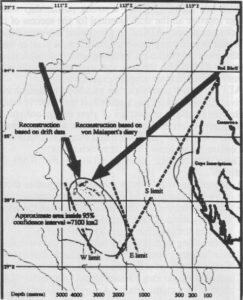- Author
- Kirsner, Professor Kim, (UWA) and Hughes, Sam, (AMSA)
- Subjects
- WWI operations
- Tags
-
- RAN Ships
- HMAS Sydney II
- Publication
- March 1994 edition of the Naval Historical Review (all rights reserved)
[Update from John Date: Following an intimation in the September 1993 issue of our journal NAVAL HISTORICAL REVIEW by Mike McCarthy, Curator of Maritime Archaeology of the Western Australian Maritime Museum and coordinator of the search for SYDNEY II, we were advised of preparations in conducting the archival research programme.
The Naval Historical Society of Australia Inc expects to be able to keep members, and others so interested, informed of progress from time to time in these pages of our journal REVIEW.
It is evident that a herculean task is involved in piecing together what scanty evidence is available relating to the possible positioning of the Australian cruiser SYDNEY and the German raider KORMORAN. With an actual investigation within the ‘loss area’ it will be a project spread over many years.


The size of the operation becomes apparent in reading this edited summary of material contained in Report No. 71 (Nov. 1993)
(Copies of the report are available from the Western Australian Maritime Museum priced at $15).]
[Ed: The report’s authors are Professor Kim Kirsner (University of Western Australia) and Sam Hughes (Australian Maritime Safety Authority)]
This report was commissioned by the Western Australian Maritime Museum and is based on material, analysis and arguments supplied by Alan Pearce (CSIRO), John Penrose (Curtin University of Technology), Madeleine Gauntlett (Curtin University of Technology), Ray Steedman (Steedman Engineering), Gordon Laffer (Consultant) and Ean McDonald (Consultant).

The above panel has set out, firstly, to identify the critical processes (i.e., wind, sea surface current, etc.) which underlies any variation; secondly, to co-ordinate and describe a review process which was implemented to identify consensual estimates of the relevant value for each process, and; thirdly, to provide probable and possible estimates of the site or sites of the wrecks.
In the first instance, they considered positions provided by officials and historians since the engagement. According to John Curtin for example (Montgomery, 1981), the battle took place “300 miles west of Carnarvon”. Was the then Prime Minister of Australia just being geographically lax, for the position which he indicated was never even reached by SAR aircraft, or was he deliberately providing a false position for the benefit of his country’s enemies? Ruge (1957), who, it may be assumed, had direct contact with KORMORAN survivors, provided a similarly vague position, which receives no support from other sources.
Gill (1957) used the position supplied by the KORMORAN survivors, and assumed that the location supplied by them was accurate to the minute. It should be noted however that he used the initial co-ordinates despite the fact that this report did not include any reference to minutes as distinct from degrees. Among more recent accounts, Winter (1984) accepted the position provided by the KORMORAN survivors, while Montgomery (1981, 1983) provided a new position just south of Cape Inscription.
Considered as a set, the positions provided by these accounts cover more than four degrees of longitude and nearly two degrees of latitude, about 80,000 km. The analysis described below is based primarily although not exclusively on conventional Search and Rescue procedures.
The product is a by no means precise ‘probable target area’ of approximately 7,100 km. For comparison, the final searches for TITANIC and BISMARCK involved area of approximately 500 km.
It may be noted, furthermore, that Ballard (1987, 1990) and his colleagues had good reasons for being virtually 100% certain that the target areas actually included the targets. This degree of confidence is not justified for the ‘probably search area’ here identified. There are too many question marks hanging over assumptions about the underlying variables. In this report a measure of consensus has been achieved. But, unfortunately, variability in the direction and velocity of winds and sea currents is not achieved by consensus.
Also considered were:- (1) drifting objects without sailing potential, that is, the life-rafts, floats, dog kennel and oil; (2) two life-rafts with sailing potential; (3) sailing of a lifeboat from KORMORAN by B/Meyer and based on a diary kept by an occupant von Malapert; (4) comparison of sailings of other lifeboats by B/Detmers, B/Gosseln and B/Kuhl; and (5) tracks of SYDNEY’s previous voyages under the same directions.




